|
|
|
| I've built a number of carts over time, they are used to support my shop in some manner. The carts shown here are mainly for storage. Woodworkers need to store a variety of material. A good storage solution allows items to be located quickly and stores items in the least possible space thus freeing space for more important uses. All of these carts are mobile. |
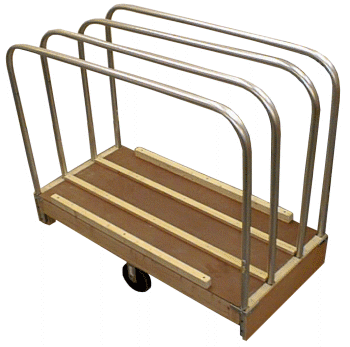 |
This is a cart that I use to store plywood. I had a restraint on
the design (it had to fit through a doorway), this is what limits the width and thus how
much it can carry. Its bas is a large torsion box. Four 5 inch castors are mounted to the
bottom in a diamond pattern. The two at the sides are fived and the two on the ends (not
visible) are swivle types. This pattern allows it to turn within its own radius.
This makes it pretty maneuverable in one respect but makes it require more space to
maneuver next to something as well; like when you want to park it next to a wall. The cart
is very easy to move even fully loaded. I separated the storage into three areas by using one inch conduit. I put shorts in one, full or nearly full sheets in the center, and longs in the other. The conduit is bolted to the base and an additional brace is added to the ends to strengthen them. In addition, I placed 16" hardwood dowels inside the conduit to make them strong and the likely point of failure. This cart isn't all that big, it only holds offcuts and the plywood that I like to have on hand for general purpose use. is |
| This a cart for small cut offs. One section is basically a
cabinet with drawers an shelves. The other is a platform that is used to store small
pieces of plywood that is too small to access easily on the plywood cart or some medium
length scrap. The base of this cart is a torsion box and has four 5 inch castors in a diamond pattern like the plywood cart.. The cart is easy to maneuver and move but if I were building another I think I would use wheels. On the platform side I used a piece of conduit to form an open retainer, this allows items to be looked through pretty easily. The cabinet is some low grade Melamine build using simple shallow dados. Because even ¾" Melamine will sag under it's own weight, I experimented with a different method for building the shelves. Basically they are thin torsion boxes with 1/8" thick hardboard skins, these seem to work very well. My original intent was to build two large drawers instead of the four smaller ones shown here. Upon reflection I realized they did not need to be so big and I could actually store more with more smaller drawers. My original design also called for false fronts on the drawers but after building the drawers I just didn't want to cover up their box joints. |
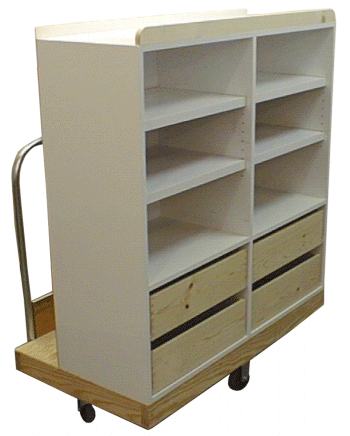 |
| This cart size was also constrained by the need to fit through a doorway. Although this cart stores more than its predecessor, it still isn't quite big enough. One key to storing cut-offs is to go through them periodically and to pitch the lower value items out. Otherwise you'll eventually be buried in them. | |
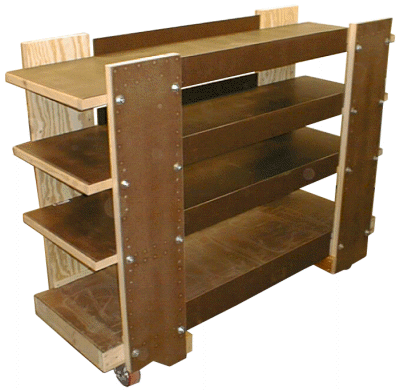 |
This is a lumber storage cart. It is six feet long, about five
feet high, and around 27" in overall width. If I were a welder I would have built
this out of steel, I'm not so it's made of wood. The challenge then with wood construction
was to build a cart strong enough to carry the load dynamically (as in being pushed by one
of its posts). I went through a couple of different designs on paper before I settled on this configuration. In my application I wanted a mobile cart but don't really need to push it around all over. I wanted it to be able to move, not to continually put it in motion; there is a subtle but important difference between these requirements. I also wanted the structure to store lumber as efficient as possible. The danger in this requirement is that one can easily put an enormous amount of lumber (and hence weight) in a deceptively small footprint. |
| The cart is comprised of several torsion boxes
bolted together. There are several reasons why I settled on the torsion box design. One is
because a torsion box makes for a very strong shelf with a relatively thin cross section.
Shelves are also full width and flat which I decided would be best for loading and
unloading lumber. Torsion boxes can also be made in virtually any size you want. The base of this cart is a thick torsion box with a ¾" ply bottom and a ¼" thick top. The bottom uses a 2x frame and cardboard to fully support the span between the frame members. I used four 6 inch wheels at the corners with a load rating of several hundred pounds each. The wheels are cast iron with a thin urethane tire, they roll very well when the cart is unloaded. I designed four wide but thin posts to carry the shelf loads.
These torsion boxes are bolted THROUGH the base with four ½" threaded rods. There is
also a small cross beam under the base that provides even more anti-racking strength to
these posts. The shelves are likewise bolted through the posts in a similar manner. The
reason for making the posts wide was to resist racking along the length of the cart. |
|
| This is a cart I sometimes use for shop purposes. It is a
fairly common utility cart, it came with a plywood deck but I replaced that with a thicker
deck and frame to make it more durable. My primary use of this is to move heavy objects back and forth from my basement or truck. I also use it to hold some big projects while I am working on them; sometimes this is the only good way I have to manipulate a large project in the confined area of my shop. |
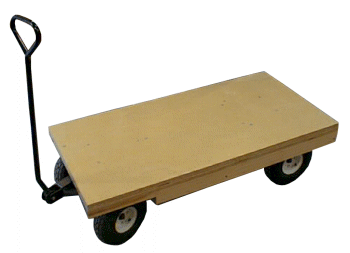 |
| The cart has pneumatic tires and an automotive steering mechanism instead of the old fashioned "radio-flyer" type. The steering mechanism is important to keep the cart from tipping over when turned tightly. | |
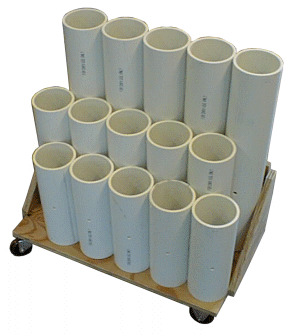 |
This is a small cart I made to hold small cutoffs, dowel stock, T-track, threaded rod, and other assorted small pieces. The cart itself is made of scrap 3/4" plywood glued and stapled together, the castors are cheap 3" units from Grizzly, the pipe is 4" PVC thick-wall. I glued the pipe together in rows then screwed the tallest row to the back of the cart, the two smaller rows were then affixed to adjacent pipes with a single screw. This cart didn't take long to build or cost too much and organizes small stick-stock quite well. The primary reason for putting wheels on the cart was because I had some laying around and to make it easier to get out of the way to clean the shop. |
| This is a cabinet I made to hold a lot of odds
and ends that are not really needed on a very frequent basis, the cabinet is located in my
basement. The cabinet is double sided, the opposite side is the same as seen here. The cabinet is mounted on a mobile base with four swivel castors, this makes it easy to twirl around to get to which ever side is needed and to move around. The cabinet is built out of 3/4" Melamine edged in pine. The shelves are made of commonly available wire shelving stock. The reason for using this instead of MCP is that it is MUCH lighter in weight, has a wire ledge to catch the back end of the drawers, and is self supporting. had the shelves been made of MCP I would have had to support the shelving in the middle of the span which would have affected the drawer spacing. |
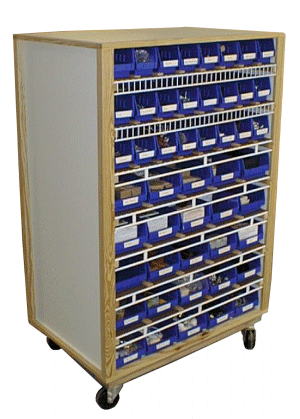 |
| The drawers are commonly available plastic parts
bins, they are a little flimsy but more than adequate for the job. The reason for
using these is that it would have taken a considerable amount of time and effort to build
this many drawers out of wood in my shop and these didn't have to be finished either.
There are 96 drawers in this cabinet. The parts cabinet has proven to be very handy and went together quickly because there wasn't a lot of finishing to do or parts to build. |
|